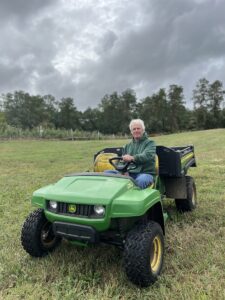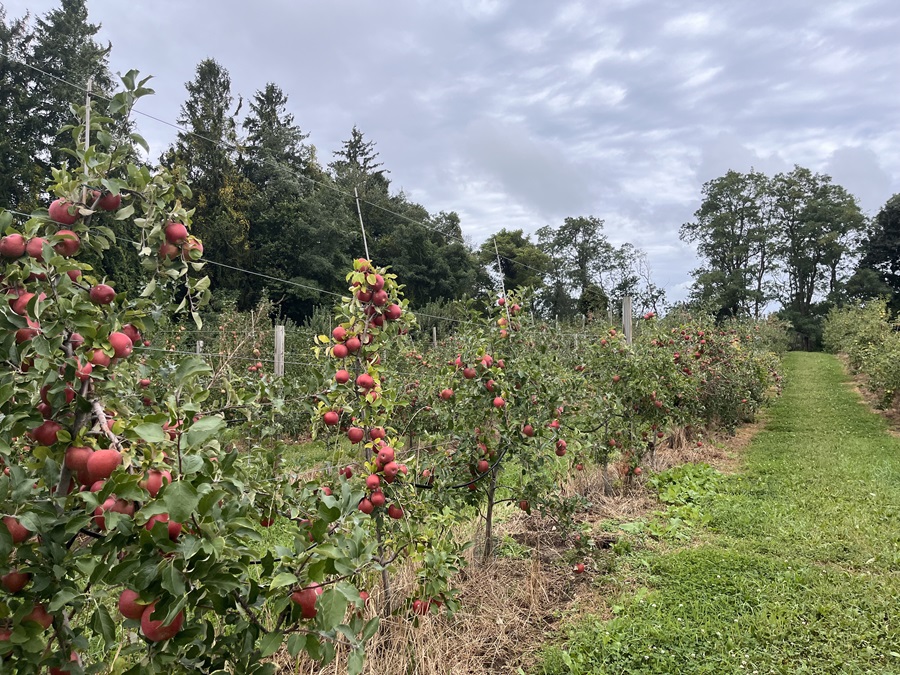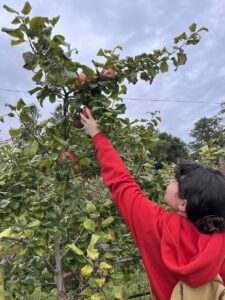Apple trees were big when I was a kid. On annual apple-picking excursions with my family, I would clamber into the branches of trees in New Jersey and sometimes in upstate New York.
Maybe it’s because I grew up in New York City, but each tree seemed like a brand-new planet, all shadowy and mysterious. I maintained a fantasy of reading my book in the elbow-crook of some sturdy branch. I wanted to disappear into the canopy, where the best apples were surely waiting. High above me, peeking out from behind leaves or swinging from a protruding branch, there awaited: Gala and McIntosh, Pink Lady and Honeycrisp.
Cape Cod isn’t known for apple orchards, at least not anymore, and especially not at our end of the peninsula, though on hills at what was Edgewood Farm in Truro and a few other places there are remnants of orchards past. But this September — my first on the Cape — I was determined to go apple picking. I’d been feeling a little more grown up than I want to be. I needed a road trip back to childhood.

After some research, Crow Farm in Sandwich was not only the closest place but the only place I found to pick your own on Cape Cod. It was an hour away. I tied up my boots, filled the car with gas, and set out the scenic way, up Route 6A. For company, I brought my twin sister, Eve, who also has memories of apple-tree escapism.
The sky was gray, but at least it wasn’t raining on Sunday as we arrived at the farm and parked in the lot with the other pickers — mostly children and their parents. The orchard spread out before us: hundreds of trees, with more over the hill and out of sight. But they didn’t look like the trees of our youth. They were tiny, tied together in orderly rows, clipped to wires and propped up by posts. “They’re all fully dwarf trees,” says orchardist Paul Crowell, “more of a plant than a tree.” They can’t hold themselves up — they’d tip over from the weight of their fruit.
We didn’t have to look up very far to find the apples. There was no search under big canopies or wishing for a ladder. They were right in our faces. Picking them felt somewhat like berry-picking: easy as pie.
Crowell’s grandparents started the family’s farm here a little over 100 years ago. It was a small dairy, then sold produce from a farm stand, which Crowell closed in 2020, though he still sells peaches wholesale and bedding plants in the spring. He’s been growing dwarf apple trees there for about 12 years. Now, the pick-your-own apples are the main attraction. And the corn maze. I saw the entrance to the maze in the distance, but if apple trees were planets, I remembered corn mazes as galaxies. They would be time-bending.

Crow Farm is 50 acres, says Crowell, but the orchard doesn’t claim all that space. Crowell has about 4,000 trees, representing 20 varieties, all pickable from the ground, no climbing required.
We each took a one-peck bag — these, too, seemed smaller than the ones I remembered lugging home as a kid — and we filled them quickly. The Honeycrisps were practically glowing, yellow and green and pink. More sweet than tart, they were refreshingly crisp; we piled them into our bags first. Galas were next: a little smaller and garnet red, with a hint of pear-like sweetness, and so much better than the supermarket crop. The Cortlands were softer-textured and don’t keep as well, but we knew they’d be perfect for baking and topped up our bags with them.
We told Crowell about our memories of apple picking in New York. It’s a “romantic notion,” the idea of disappearing into an apple tree, he says. “I can remember, as a kid, we used to have giant old apple trees. I could spend 45 minutes pruning one tree. There were maybe 25 or 30 trees on an acre.” Buried in the middle of a deep tree, hidden from the sun, the apples were smaller and less colorful.
With dwarf trees, he says, he can grow 1,000 on an acre. They’re easier to prune, which he does in the winter, thinning out the excess growth. The apples are bigger and brighter. It’s easier to control pests without the dense canopy of a big tree in the way. “From a production standpoint,” he says, “it’s far superior, more convenient, and you get a much better product out of it.”

Dwarf trees do have their challenges. They need consistent moisture, he says. “They don’t have the really deep root system to get down to where the soil is moist.” To keep them hydrated, he uses a drip irrigation system. “And there’s a lot of mowing,” he says. That’s because extra grass or weeds would actually sap enough moisture away from them to be an issue.
These little trees weren’t strong like the ones I remembered. They weren’t planets. They had no width; I could see right through them. At their highest, the apples were still within reach.
I thought a little about my own size. Was it possible I had inflated the trees in my memory, forcing them to grow as I have done? No, I decided. Those old trees still existed somewhere. Just not here.
Here, the fruit was multitudinous, though, and the children around me were squealing and gnawing on apples nearly as large as their faces. To my right, two weighty apples shared a stem and were dragging their branch down almost to the ground. I picked them and watched the branch spring back up in relief.
Eve and I had our prize: two pecks of apples for $60 and plans for the days ahead — plans that would work just fine even when it was cold and rainy out: apple pies and applesauce, apple crisps and plain old apples for eating.
Everything might have been smaller than what I remembered, but these apples were bigger than the ones from my childhood, and I bought them without asking my parents for permission. We drove an hour home, no longer so down about growing up.



